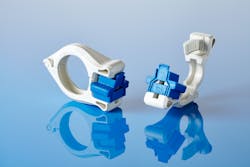It wasn’t that long ago that pharmaceutical manufacturers had only limited applications for single-use technologies. But times have changed. These days, disposable components are becoming a more common feature of facility design from upstream to downstream processing. The reasons for this change are clear: Single-use components reduce the risk of contamination, and can be less expensive, easier to use and provide more flexibility than traditional processing technologies.
To learn more on this growing trend, Pharmaceutical Manufacturing reached out to several industry experts and got fresh insights on how single-use technologies are changing the game.
A Streamlined Supply Chain
As the market for single-use technologies has matured, suppliers have become more adept at innovating components to meet a growing number of manufacturing needs. But sourcing components from different suppliers can cause complexity in the manufacturing process. Now, the supply chain is moving closer to achieving a more universal approach to how components are fitted and designed.
“A robust and secure supply chain of single-use technology products and components is one of the more important, if under-appreciated trends in bioprocessing,” says Don Young, a senior product manager of single-use BioProcess Containers at Thermo Fisher Scientific. “As this once-disruptive technology matures, the successful single-use product supplier will emphasize production and delivery execution, and producing high quality, fit-for-purpose single-use products delivered with short lead times and without any disruption in supply.”
Jennifer Johnson, a senior marketing specialist at Parker Hannifin Manufacturing, echoes these sentiments.
“Recent trends and surveys point towards a need for a simplification in the way that people are designing and using single-use assemblies,” Johnson says. “This, coupled with the need for clean processes and providing just-in-time stocking levels with reduced inventory level management, has led to a desire to implement universal assemblies.”
Increased Capabilities
The rise in demand for biologics and biosimilars has made maintaining sterility a growing challenge for manufacturers. Because single-use systems reduce or eliminate the need to conduct CIP/SIP operations, they can help ease compliance burdens for biopharma manufacturers.
The innovations have also given manufacturers new tools and flexibility for facility design.
“The range of single-use systems has been growing for a number of years now and as a result, it is becoming evident that plant designers and operators can rely on a large number of additional components such as bioreactors, sensors and pumps,” says Heather Petty of GEM Valves. “This is because single-use systems did not have the full range of functions compared to their counterparts from traditional plant engineering.”
These limitations have been resolved with the innovation of many new components including diaphragm valves. And other single-use technologies are being continuously improved to meet regulatory and manufacturing demands.
“One of the trends in single-use design is around processes having higher pressure requirements, especially as bioprocesses are requiring higher volume fluid flow,” says Alex Kakad the product marketing manager of AdvantaPure. “Application areas such as virus filtration, TFF systems, and inline filter integrity testing require single-use assemblies and tubing to be able to handle working pressures of up to 60 psi. The challenge for designers is to have cost-effective materials that are durable enough to handle these pressure requirements, translucent enough to allow for process monitoring, and to have the supporting validation information to allow for their use in a bioprocess environment.”
Single-use technologies can also give manufacturers more flexibility with their environment.
“In a highly classified environment, open connectors such as quick connects are acceptable because the environment is inherently less risky than a lower-class environment,” says Todd Andrews, global sales and business development manager of bioprocessing at CPC. “More and more, though, drug manufacturers are producing products outside of highly classified environments to improve flexibility and reduce overhead. Now, manufacturers increasingly seek sterile connectors to ensure product integrity and quality is maintained in these broadened manufacturing locations.”
Cost-Effectiveness
As manufacturers continue to weigh the benefits of disposables versus traditional parts, it’s important to evaluate the total cost of use instead of just the initial price tag. In the long run, the savings from decreased equipment upkeep often makes single-use a better option.
“Disposable components sometimes have higher per-unit costs, but they eliminate other costs such as power and water usage to generate steam to sterilize components,” Andrews says. “Also, cleaning and sterilizing reusable equipment between usages requires downtime. With disposables, manufacturing can be up and running immediately after replacing the disposable assembly.”
And as the market grows, single-use technology options continue to evolve towards ever-changing industry needs.
